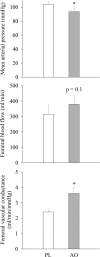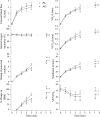Ascorbate infusion increases skeletal muscle fatigue resistance in patients with chronic obstructive pulmonary disease
- PMID: 24068051
- PMCID: PMC3841801
- DOI: 10.1152/ajpregu.00360.2013
Ascorbate infusion increases skeletal muscle fatigue resistance in patients with chronic obstructive pulmonary disease
Abstract
Chronic obstructive pulmonary disease (COPD) is associated with systemic oxidative stress and skeletal muscle dysfunction. The purpose of this study was to examine the impact of intravenous ascorbate administration (AO) on biological markers of antioxidant capacity and oxidative stress, and subsequently skeletal muscle function during dynamic, small muscle mass exercise in patients with COPD. Ten patients with spirometric evidence of COPD performed single-leg knee extensor (KE) trials matched for intensity and time (isotime) following intravenous ascorbate (2 g) or saline infusion (PL). Quadriceps fatigue was quantified by changes in force elicited by maximal voluntary contraction (MVC) and magnetic femoral nerve stimulation (Qtw,pot). AO administration significantly increased antioxidant capacity, as measured by the ferric-reducing ability of plasma (PL: 1 ± 0.1 vs. AO: 5 ± 0.2 mM), and significantly reduced malondialdehyde levels (PL: 1.16 ± 0.1 vs. AO: 0.97 ± 0.1 mmol). Additionally, resting blood pressure was significantly reduced (PL: 104 ± 4 vs. AO: 93 ± 6 mmHg) and resting femoral vascular conductance was significantly elevated after AO (PL: 2.4 ± 0.2 vs. AO: 3.6 ± 0.4 ml·min(-1)·mmHg(-1)). During isotime exercise, the AO significantly attenuated both the ventilatory and metabolic responses, and patients accumulated significantly less peripheral quadriceps fatigue, as illustrated by less of a fall in MVC (PL: -11 ± 2% vs. AO: -5 ± 1%) and Qtw,pot (PL: -37 ± 1% vs. AO: -30 ± 2%). These data demonstrate a beneficial role of AO administration on skeletal muscle fatigue in patients with COPD and further implicate systemic oxidative stress as a causative factor in the skeletal muscle dysfunction observed in this population.
Keywords: ascorbate; free radicals; peripheral fatigue.
Figures





References
-
- Allen DG, Lamb GD, Westerblad H. Skeletal muscle fatigue: cellular mechanisms. Physiol Rev 88: 287–332, 2008 - PubMed
-
- Amann M, Calbet JA. Convective oxygen transport and fatigue. J Appl Physiol 104: 861–870, 2008 - PubMed
-
- Benzie IF, Strain JJ. The ferric reducing ability of plasma (FRAP) as a measure of “antioxidant power”: the FRAP assay. Anal Biochem 239: 70–76, 1996 - PubMed
Publication types
MeSH terms
Substances
Grants and funding
LinkOut - more resources
Full Text Sources
Other Literature Sources
Medical
Miscellaneous

